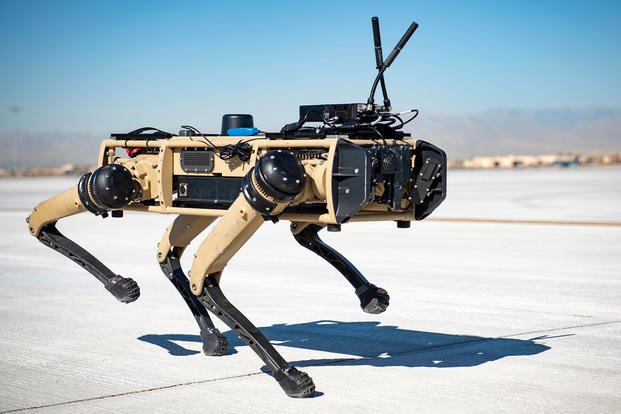The Army is considering outfitting a “robot dog” unmanned robot with its new infantry rifle to “explore the realm of the possible” for future close combat, a service spokesman told Military.com.
Bhavanjot Singh, a senior scientific technical manager at the Army’s Combat Capabilities Development Command (DEVCOM), first mentioned potentially arming a Ghost Robotics-manufactured Vision 60 Quadruped Unmanned Ground Vehicle (Q-UGV) with the Army’s Next Generation Squad Weapon rifle during a late July reception with lawmakers in Washington, D.C., as Janes first reported earlier this month.
The Army has already experimented with mounting an M4A1 carbine on a Q-UGV, according to Janes. But testing the new Sig Sauer XM7 rifle would mark a new frontier for the use of the unmanned robots meant to emulate some of the skills of man’s best friend.
“The unique capability of the dog is the ability to traverse different types of terrain that wheeled vehicles may not be able to go,” Singh reportedly told lawmakers.
When asked about Singh’s remarks, DEVCOM spokesman Tim Ryder told Military.com that Army Futures Command “continues to explore the application of human machine integration,” while cautioning that the development of a prototype doesn’t indicate the weaponized robot dogs will be deployed downrange.
“While advanced technology demonstrations — in this case, related to the Next Generation Squad Weapon and unmanned ground vehicles — allow us to explore the realm of the possible when it comes to transformative capabilities for future combat formations, they don’t necessarily represent or result in formal service-wide research programs or investments,” Ryder said in an email.
Using 6.8mm ammo, the XM7 rifle and its sister weapon, the XM250 automatic rifle, were adopted under the NGSW program in 2022 to replace the M4 carbine and M249 Squad Automatic Weapon respectively in Army arsenals within the next decade. While already popular among U.S. special operations forces, Military.com previously reported that some soldiers expressed concern that the XM7 is too large and heavy to function effectively as a standard infantry rifle.
Meanwhile, robot dogs like the Vision 60 Q-UGV have become an increasingly common fixture across the U.S. military, performing functions like enhancing perimeter security at various installations; augmenting intelligence, surveillance, target acquisition, and reconnaissance (ISTAR) capabilities for troops in remote environments; and even carrying out some explosive ordnance disposal tasks at the behest of their uniformed operators.
While semi-autonomous and remotely controlled weapons platforms are already established tools in the U.S. military’s toolkit, the prospect of arming robot dogs and sending them into hostile territory alongside U.S. troops has triggered controversy in the robotics industry. Half a dozen robotics companies, including leading firm Boston Dynamics, released a letter last October calling on global militaries to abstain from weaponizing their technology.
“We believe that adding weapons to robots that are remotely or autonomously operated, widely available to the public, and capable of navigating to previously inaccessible locations where people live and work, raises new risks of harm and serious ethical issues,” the companies said. “Weaponized applications of these newly-capable robots will also harm public trust in the technology in ways that damage the tremendous benefits they will bring to society.”
Those concerns haven’t stopped defense contractors from developing novel combinations of unmanned ground robots and weapons systems. In October 2021, Ghost Robotics and SWORD International unveiled a so-called Special Purpose Unmanned Rifle robot dog equipped with a 6.5mm Creedmoor rifle at the Association of the U.S. Army’s annual conference in Washington, D.C. One year later, a viral video from Chinese defense contractor Kestrel Defense showed an unmanned aerial vehicle airdropping a robot dog armed with a Chinese 5.8x42mm QBB-97 light machine gun onto a rooftop during a training simulation.
Thus far, officials with the Army’s robotics program have said that the service likely won’t deploy unarmed mechanized canines alongside soldiers for another decade at least.
Multi-legged ground robots “have some promises which we’ve identified, primarily from a mobility standpoint. … [But] there are limitations to them as well from an endurance [perspective], as well as the payload capability and power of how much they can support,” Milot Resyli, the chief of dismounted robotic systems at DEVCOM’s Ground Vehicle Systems Center, told C4ISRNET this past October.
When armed versions are eventually employed, the Defense Department remains committed “to developing and employing all weapon systems, including those with autonomous features and functions, in a responsible and lawful manner,” Deputy Secretary of Defense Kathleen Hicks wrote this past January as part of the Pentagon’s latest update to DoD Directive 3000.09,
“Autonomy in Weapons Systems,” which dictates rules for buying autonomous systems.
Please rate this CIBA article
Vote






